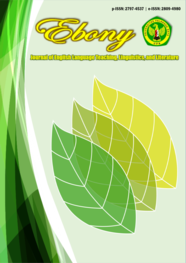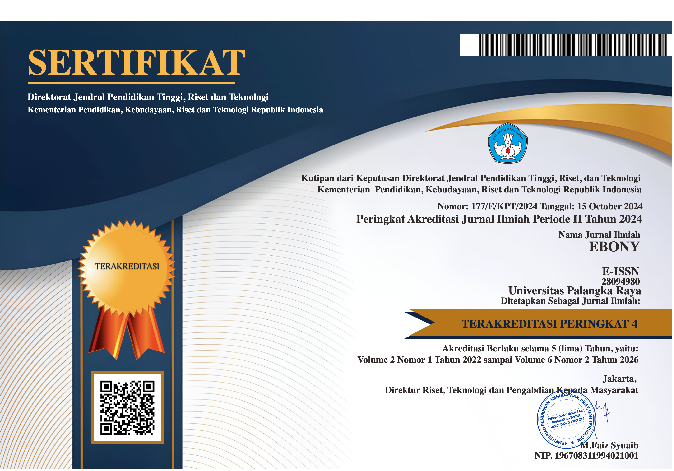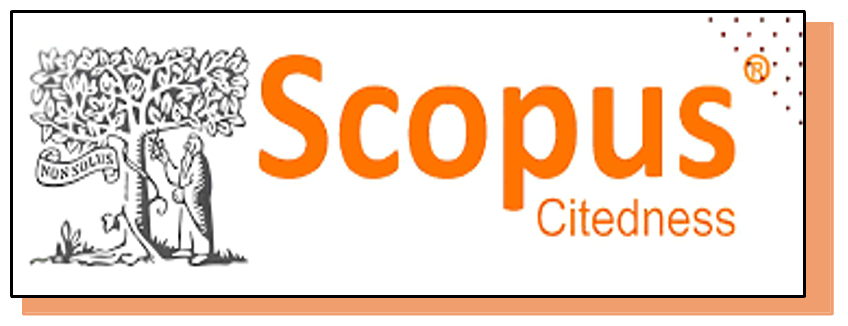Exploring Clause Complexity: A Comprehensive Analysis of a Student’s Narrative Text on Central Kalimantan Folklore
DOI:
https://doi.org/10.37304/ebony.v5i1.17440Keywords:
clause complexity, taxis, logico-semantic relations, narrative text analysisAbstract
Writing cohesive and engaging narrative texts requires effective use of clause complexity to convey meaning and maintain reader interest. This research examines clause complexity in a narrative text written by a student in the English Education Program at the University of Palangka Raya, focusing on Central Kalimantan folklore. Using a qualitative approach with content analysis and Systemic Functional Linguistics (SFL), the research applies Halliday and Matthiessen’s (2013) framework, emphasizing taxis (parataxis and hypotaxis) and logico-semantic relations, including expansion (elaboration, extension, and enhancement) and projection (locution and idea). The text was chosen for its thematic relevance, generic structure, language features, and clause diversity. Results show paratactic constructions dominate, comprising 77% of the total clauses, reflecting the student’s preference for coordination to ensure readability and clarity. Paratactic extension (27%) and enhancement (17%) highlight effective idea connection and context, while paratactic locution (33%) underscores the role of dialogue in engaging readers. Hypotactic constructions, at 13%, focus on idea projection and enhancement (10%), indicating limited use of subordination for expressing complex relationships. These findings underline the importance of mastering both coordination and subordination techniques for cohesive, meaningful narratives. The research provides insights for educators to enhance students' clause usage in academic writing.
Downloads
References
Andersen, T. H., & Holsting, A. E. M. (2018). Clause complexing in systemic functional linguistics–towards an alternative description. Functional Linguistics, 5, 1-25. https://doi.org/10.1186/s40554-018-0059-7
Daryanti, D. (2018). An analysis of students’ difficulties in finding the moral value of narrative text at the first semester of the eighth grade of MTs N 1 Bandar Lampung in 2017/2018 academic year (Doctoral dissertation, UIN Raden Intan Lampung). https://repository.radenintan.ac.id/id/eprint/3351
Derewianka, B. (1990). Exploring how texts work: Primary English Teaching Association. Rozelle, NSW, Australia.
Egan, T. (2008). Non-finite complementation: A usage-based study of infinitive and-ing clauses in English (Vol. 65). Brill.
Eggins, S. (2004). An introduction to systemic functional linguistics (2nd ed.). Continuum.
Gerot, L., & Wignell, P. (1994). Making sense of functional grammar (pp. 192-217). Cammeray, NSW: Antipodean Educational Enterprises.
Goźdź-Roszkowski, S. (2021). Corpus linguistics in legal discourse. International Journal for the Semiotics of Law-Revue internationale de Sémiotique juridique, 34(5), 1515-1540. https://doi.org/10.1007/s11196-021-09860-8
Halliday, M. A. K. (1994). (1985)] An introduction to functional grammar. London: Edward Arnold.
Halliday, M. A. K., & Matthiessen, C. M. (2013). Halliday's introduction to functional grammar. Routledge.
Halliday, M. A. K., & Webster, J. J. (Eds.). (2009). Continuum companion to systemic functional linguistics. London: Continuum International Publishing Group.
Ifadloh, N., & Nufus, Z. (2017). The analysis of clause complex in the students’ casual conversation. LET: Linguistics, Literature and English Teaching Journal, 7(2), 120-133. https://doi.org/10.18592/let.v7i2.1945
Ikrimah, I., & Luardini, M. A. (2024). Exploring clause complexity: A detailed analysis within a specific text. Intensive Journal, 7(1), 55-63. http://dx.doi.org/10.31602/intensive.v7i1.13221
Kafrawi, M. (2022). Meningkatkan kemampuan menulis kreatif untuk siswa SMK Labor Pekanbaru. BIDIK: Jurnal Pengabdian kepada Masyarakat, 3(1), 43-46. https://doi.org/10.31849/bidik.v3i1.11420
Karapetyan, R., & Apresyan, M. (2017). Analysis of inserted clauses in the legal discourse from the pragmatic perspective. International Journal of Applied Linguistics and English Literature, 6(4), 86-90. https://doi.org/10.7575/aiac.ijalel.v.6n.4p.86
Kurniawan, C., Luardini, M. A., & Karani, E. (2021). The analysis of clause complex of analytical exposition texts written by the English teachers of SMKN 2 Palangka Raya. Intensive Journal, 4(2), 24-32. http://dx.doi.org/10.31602/intensive.v4i2.5745
Leong Ping, A., & Wee Bee, G. (2005). Investigating the clause complex: An analysis of exposition-type essays written by secondary school students in Singapore. ITL-International Journal of Applied Linguistics, 149(1), 47-76. https://doi.org/10.2143/ITL.150.0.2004372
Magfiroh, I., Herdiawan, R. D., & Rofi'i, A. (2021). An appraisal analysis of narrative text from the 11th grade English textbook. Allure Journal, 1(1), 63-75. https://doi.org/10.26877/allure.v1i1.9270
Ma'mun, N. (2017). Grammatical intricacy on students’ writing. Vision: Journal for Language and Foreign Language Learning, 6(1), 30-40. https://doi.org/10.21580/vjv6i11619
Nafisah, S., & Budiarso, I. (2023). Penggunaan kalimat majemuk bahasa Inggris pada teks poster digital di instagram. Jurnal Cakrawala Ilmiah, 2(5), 2083-2096. https://doi.org/10.53625/jcijurnalcakrawalailmiah.v2i5.4737
Wang, F. M. (2020). An analysis of the use of clause complex in scientific journals. Journal of Education and Entrepreneurship, 7(1), 56-65. https://link.gale.com/apps/doc/A665975312/AONE?u=anon~b4afcf1f&sid=googleScholar&xid=1785aaae
Yuniar, R. (2018). Logico-semantic relation of clauses used in analytical exposition written by the third semester students of English department. Journal of Research on Applied Linguistics, Language, and Language Teaching, 1(2), 121-121. https://doi.org/10.31002/jrlt.v1i2.247
Downloads
Published
How to Cite
Issue
Section
License
Copyright (c) 2025 Mimo Lalito Erisyerico, Maria Arina Luardini

This work is licensed under a Creative Commons Attribution 4.0 International License.











